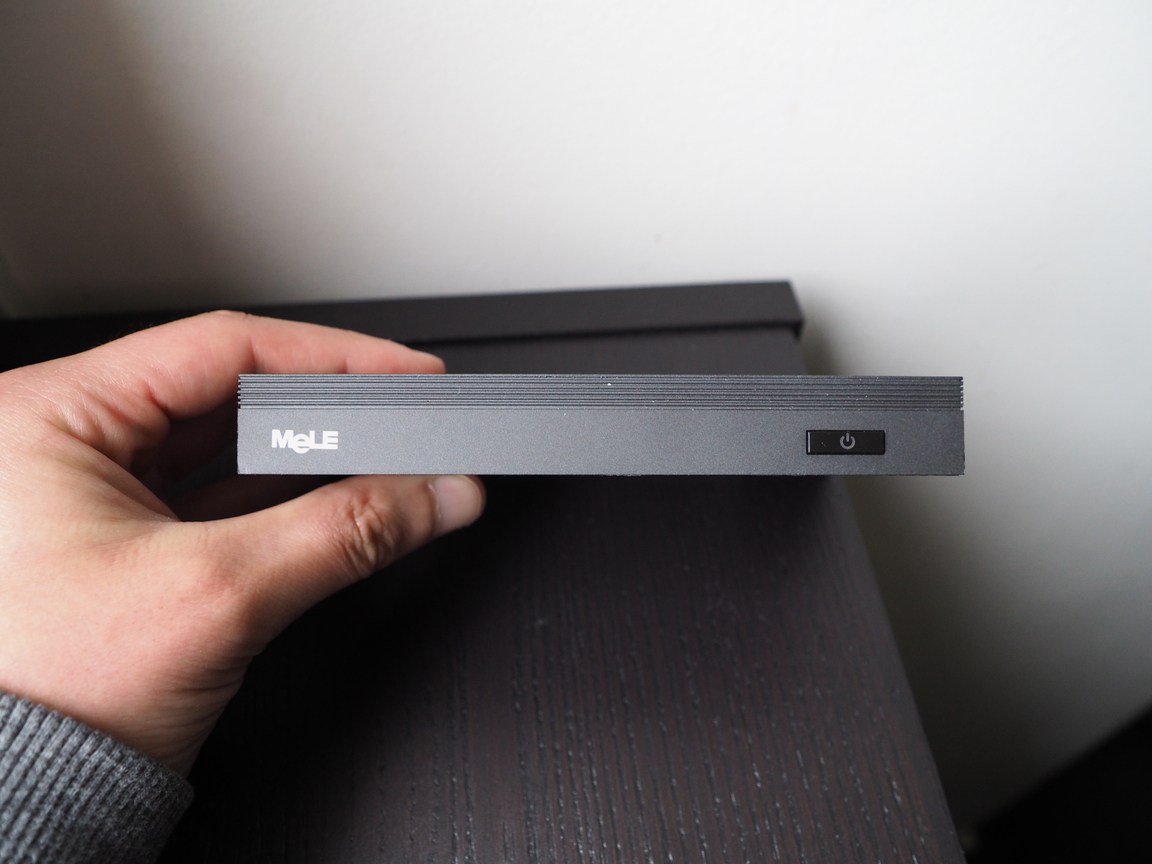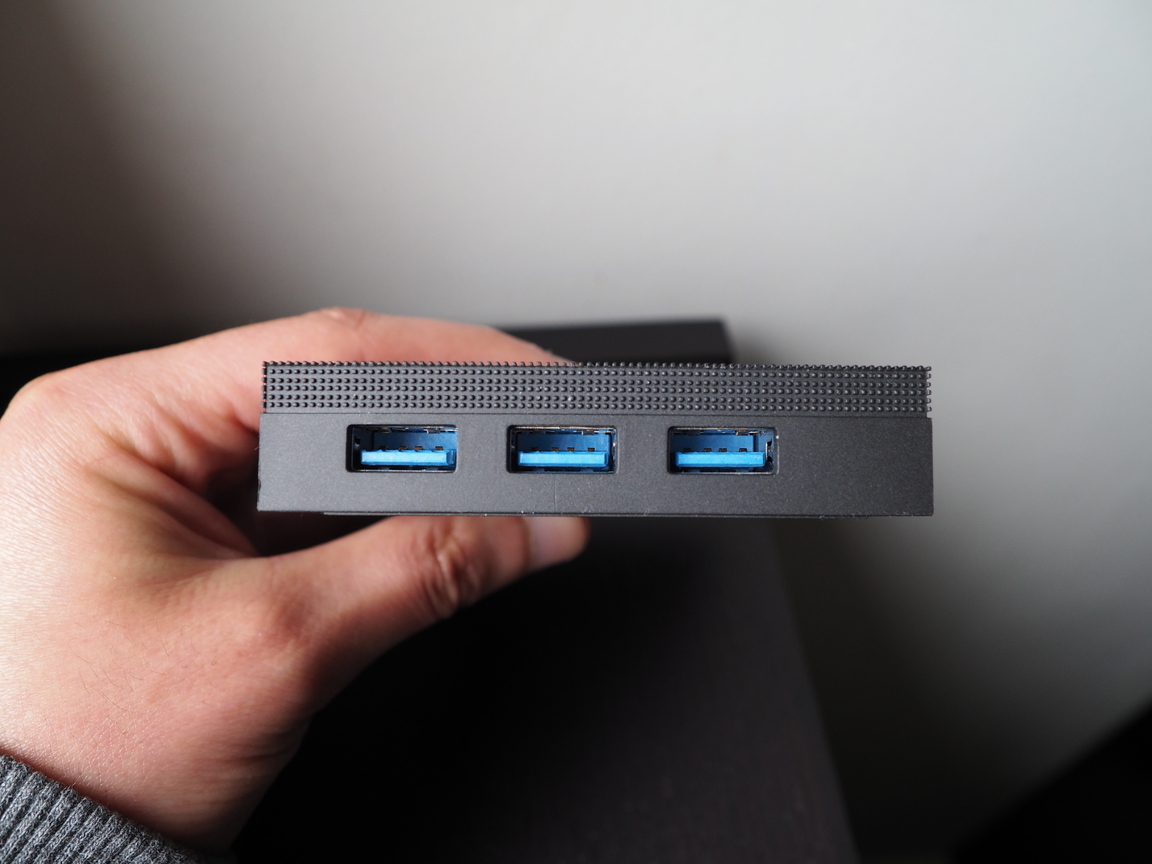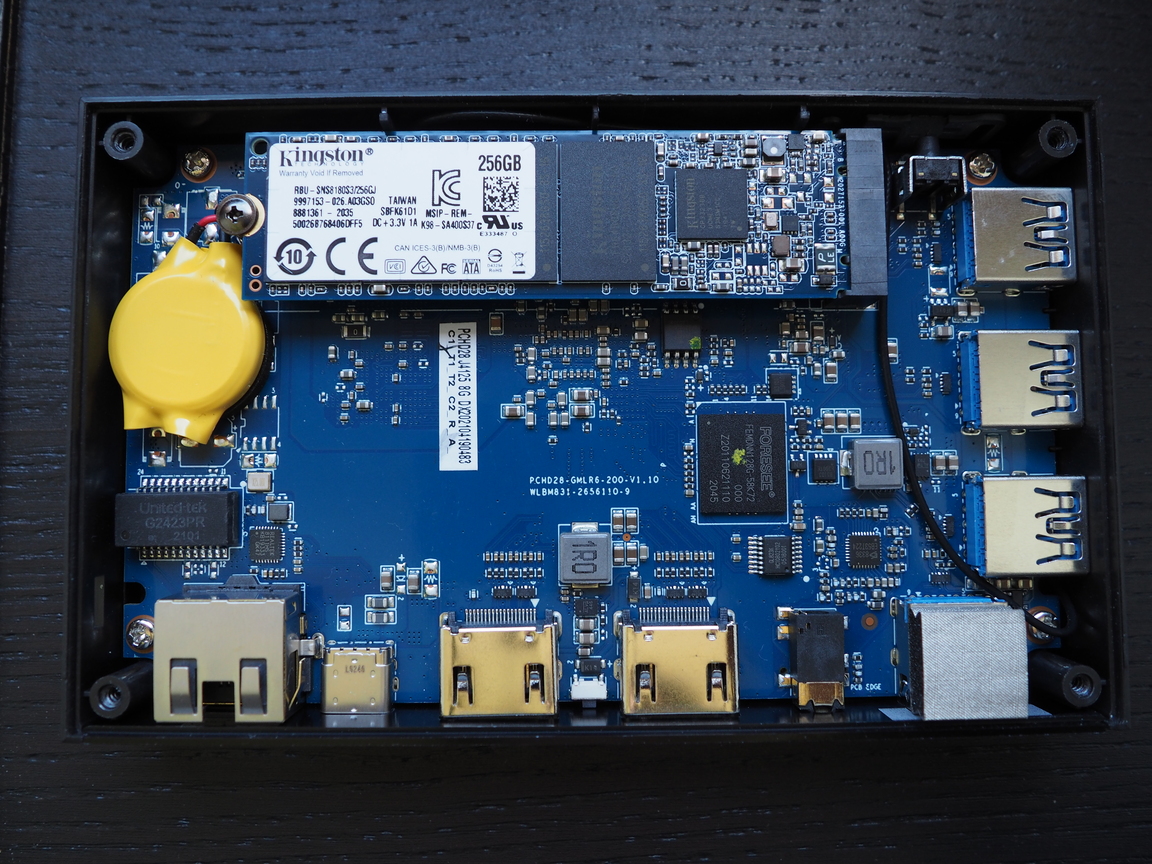Introduction
At first glance, the MeLE Quieter2 is a mini-PC with a lot of qualities: it is a fanless and very compact machine with good connectivity for about 200€.
With its Celeron J4125 CPU and its 8GB of RAM, this little computer could be the ideal companion for a server, a spare PC or even a main machine.

Source : mele.cn
I heard about this machine thanks to the excellent minimachines.net blog (article on the MeLE Quieter2) and bought it on 2021-05-04 for 201.58€ on aliexpress. The delivery was fast as I received the machine the 2021-05-12.
It is also possible to buy a VESA kit on the MeLE aliexpress store to install the computer behind a screen.
Specs
| CPU | Intel Celeron J4125 |
| RAM | 8 GB DDR4 2133 MHz |
| Storage | eMMC 128 GB + M.2 2280 |
| Video connection | 2 HDMI |
| Audio connectivity | combo jack |
| Connectivity | 4 USB 3.0, micro SD, Gigabit Ethernet |
Here’s what the inxi and lspci linux utilities find on the Quieter2.
$ inxi -b
System: Host: MeLE Kernel: 5.12.8-arch1-1 x86_64 bits: 64 Desktop: dwm 6.2 Distro: Arch Linux
Machine: Type: Mini-pc System: MeLE product: Quieter2 v: N/A serial: <superuser required>
Mobo: MeLE model: Rev GMLR1 1.10 serial: <superuser required> UEFI: American Megatrends v: 10.0 date: 04/01/2021
CPU: Info: Quad Core Intel Celeron J4125 [MCP] speed: 1306 MHz min/max: 800/2700 MHz
Graphics: Device-1: Intel UHD Graphics 605 driver: i915 v: kernel
Display: x11 server: X.org 1.20.11 driver: loaded: modesetting resolution: <missing: xdpyinfo>
OpenGL: renderer: Mesa Intel UHD Graphics 600 (GLK 2) v: 4.6 Mesa 21.1.1
Network: Device-1: Realtek RTL8111/8168/8411 PCI Express Gigabit Ethernet driver: r8169
Device-2: Realtek RTL8821CE 802.11ac PCIe Wireless Network Adapter driver: rtw_8821ce
Drives: Local Storage: total: 353.71 GiB used: 7.89 TiB (2283.6%)
Info: Processes: 189 Uptime: 3h 33m Memory: 7.59 GiB used: 4.28 GiB (56.3%) Shell: fish inxi: 3.3.04
$ lspci
00:00.0 Host bridge: Intel Corporation Gemini Lake Host Bridge (rev 06)
00:00.1 Signal processing controller: Intel Corporation Celeron/Pentium Silver Processor Dynamic Platform and Thermal Framework Processor Participant (rev 06)
00:02.0 VGA compatible controller: Intel Corporation UHD Graphics 605 (rev 06)
00:0e.0 Multimedia audio controller: Intel Corporation Celeron/Pentium Silver Processor High Definition Audio (rev 06)
00:0f.0 Communication controller: Intel Corporation Celeron/Pentium Silver Processor Trusted Execution Engine Interface (rev 06)
00:12.0 SATA controller: Intel Corporation Celeron/Pentium Silver Processor SATA Controller (rev 06)
00:13.0 PCI bridge: Intel Corporation Gemini Lake PCI Express Root Port (rev f6)
00:13.2 PCI bridge: Intel Corporation Gemini Lake PCI Express Root Port (rev f6)
00:14.0 PCI bridge: Intel Corporation Gemini Lake PCI Express Root Port (rev f6)
00:15.0 USB controller: Intel Corporation Celeron/Pentium Silver Processor USB 3.0 xHCI Controller (rev 06)
00:16.0 Signal processing controller: Intel Corporation Celeron/Pentium Silver Processor Serial IO I2C Host Controller (rev 06)
00:1c.0 SD Host controller: Intel Corporation Celeron/Pentium Silver Processor SDA Standard Compliant SD Host Controller (rev 06)
00:1f.0 ISA bridge: Intel Corporation Celeron/Pentium Silver Processor LPC Controller (rev 06)
00:1f.1 SMBus: Intel Corporation Celeron/Pentium Silver Processor Gaussian Mixture Model (rev 06)
02:00.0 Ethernet controller: Realtek Semiconductor Co., Ltd. RTL8111/8168/8411 PCI Express Gigabit Ethernet Controller (rev 15)
03:00.0 Network controller: Realtek Semiconductor Co., Ltd. RTL8821CE 802.11ac PCIe Wireless Network Adapter
Design

Fanless, the computer is very compact. It is a rectangle of 13.1 cm by 8 with a thickness of 1.8 cm.
The chassis is well finished and sturdy, and the overall design is nice. Note that the outer shell is made out of plastic, but the bottom plate and the IO shield are made of metal. The top of the chassis is composed of grooves that help with heat dissipation. On the plus side, the LED remains discreet and won’t light up the room if you leave the PC on at night.
The Quieter2 is very light which could cause some problems: the Quieter2 will hardly stay in a fixed position on a desk once connected to a monitor and some peripherals, it will be dragged by the slightest movement of a cable.
Buying the optional VESA kit can be a good investment to fix the MeLE Quieter2 behind a screen.
In terms of connectivity, there are 4 USB 3.0 ports, a combo-jack port, a micro SD port, two HDMI ports, a Gigabit Ethernet port and a USB-C port that is only used to power the computer.



The connectivity is well thought out and all that’s missing is a real USB-C port to be able to further expand the capabilities of the machine with a USB-C hub for example.
Performance
The Celeron J4125 processor that powers the Quieter2 is a very common processor for this kind of machine. Released in 2019 on the Gemini Lake Refresh architecture, it uses a 14 nm lithography. Featuring 4 cores and 4 threads with a maximum frequency of 2.7 GHz, the whole thing fits on a 10W TDP. The graphics chipset is a UHD Graphics 600 with 12 execution units and a maximum frequency of 750 MHz.
Very positive point, the BIOS is unlocked. The number of parameters is quite impressive and it is possible to tune the machine very finely. Thus, it is possible to set the values of Power Limit 1 (PL1) and Power Limit 2 (PL2) of the Intel CPU (more information in this AnandTech article).

In the rest of this article, I will test performance with the default BIOS settings (PL1: 8W, PL2: 15W) and a configuration where PL1 and PL2 will be set to their maximum values (25W).
Beware of the default storage system, the 128GB eMMC storage is indeed not very reliable: I personally needed to do a file system check (fsck) only a few days after I bought the PC.
The file system was not corrupted but I would not trust a storage system of this type. I have since installed a M.2 SSD as main drive and I’m yet to have any issues with it.
The M.2 slot is easily accessible, just remove 4 screws under the chassis and take off the cover. Only this slot is accessible, everything else (network card, RAM, CPU) is soldered. Note that a thermal pad to stick on the M.2 SSD is provided to help dissipate heat.

Benchmarks
The performance tests were done on Archlinux, with the following software:
| Benchmark | Version | Command |
|---|---|---|
| 7z | 17.04 | 7z b |
| openssl | 1.1.1k | openssl speed sha512 |
The 7z benchmark is very CPU intensive, while the openssl benchmark is more about the single-threaded CPU performance and memory bandwidth.
Results
| PC | CPU | BIOS settings | 7z compressing | 7z decompressing | openssl 8192 | openssl 16384 |
|---|---|---|---|---|---|---|
| Chuwi Herobox | Celeron N4100 | Default | 5902 | 7092 | 212468.7 | 216926.35 |
| MeLE Quieter2 | Celeron J4125 | Default | 6360 | 8642 | 245044.91 | 246524.59 |
| MeLE Quieter2 | Celeron J4125 | 25W | 7070 | 10291 | 244460.2 | 246715.73 |
| Kimsufi VPS | Core i3 2130 | Default | 9742 | 9002 | 412491,787 | 416650,58 |
On the 7z benchmark the Celeron J4125 performs about 14% better than the Celeron N4100, a processor sold on similarly priced machines like the Chuwi Herobox.
By changing the power limits of the processor in the BIOS (PL1 and PL2 set to 25W), the performance is increased by about 15%.
When decompressing, we reach the performance of a Core i3 2310, which is a quite old CPU that consumes much more power (TDP of 65W).
In everyday use, the CPU performs very well for office and internet use and does not suffer from any major slowdowns.
Power consumption
| PC | CPU | BIOS Settings | Status | Power Consumption (W) |
|---|---|---|---|---|
| MeLE Quieter2 | Celeron J4125 | Default | Idle | 5.1 |
| MeLE Quieter2 | Celeron J4125 | Default | Full CPU Load | 11.5 |
| MeLE Quieter2 | Celeron J4125 | 25W | Idle | 5.1 |
| MeLE Quieter2 | Celeron J4125 | 25W | Full CPU Load | 17.2 |
| Chuwi Herobox | Celeron N4100 | Default | Idle | 5.3 |
| Chuwi Herobox | Celeron N4100 | Default | Full CPU Load | 10.3 |
The Quieter2 has a power consumption of about 5W at idle, and can reach 17.2W in intensive use with the CPU consumption limit set to 25W.
I used the stress CLI tool to stress-test the CPU (stress --cpu 4) and the power consumption was measured directly at the outlet with a kill-a-watt.
Temperatures
Despite its compactness, the chassis dissipates heat well.
With the CPU unlocked in the BIOS, it stabilizes around 40-50°C at rest. During more intense use such as media playback or internet browsing, the CPU can reach temperatures of around 70°C.
It is only when gaming that the Quieter2’s heat dissipation shows its limits: it reaches 96°C, which leads to thermal throttling. This is mainly due to the settings applied to the BIOS, but if you keep the default settings the temperatures will always remain around 70°C under load.
(Update 2021-05-30) Network
I had a few crashes in normal use, with average temperatures and a quite ordinary load.
Looking at the logs with journalctl , I noticed these lines just before the crashes (the REDACTED are MAC addresses):
mai 29 23:11:16 MeLE NetworkManager[488]: <info> [1622322676.9554] device (wlp3s0): set-hw-addr: set MAC address to REDACTED (scanning)
mai 29 23:11:16 MeLE kernel: rtw_8821ce 0000:03:00.0: stop vif REDACTED on port 0
mai 29 23:11:17 MeLE kernel: rtw_8821ce 0000:03:00.0: start vif REDACTED on port 0
mai 29 23:11:17 MeLE NetworkManager[488]: <info> [1622322677.5070] device (wlp3s0): supplicant interface state: inactive -> disconnected
mai 29 23:11:17 MeLE NetworkManager[488]: <info> [1622322677.9927] device (wlp3s0): supplicant interface state: disconnected -> inactive
This looks like a reset of the wifi card with the MAC address changing.
Since I only use the Ethernet connection, I have completely disabled the wifi connection management by NetworkManager with :
$ nmcli radio wifi off
I haven’t had any crashes since disabling the wifi so it seems to have fixed the problem. Unfortunately I can’t say if the issue comes from Linux, wpa_supplicant, NetworkManager or the network card itself.
Conclusion
In summary, this little computer meets all the expectations that can be made of this type of machine. The Quieter2 is powerful enough for internet and office use, all in complete silence.
Update 2021-05-30: I’ve been using my Quieter2 as my main computer for more than a week now, and it’s doing perfectly well for all usage except video games. Thanks to Steam Remote Play, I now stream my video games from my gaming pc (Ryzen 5 2600, RX 580) to my Quieter2. This adds a bit of latency but allows me not to have a noisy and overheating PC right next to me. Moreover, by switching on the PC only when I need it, it allows me to save electricity as its idle power consumption is much higher than the Quieter2’s (50W vs 5W).
Pros:
- Good design
- Fanless / good thermal dissipation
- Performance
- Low price
- Light and compact
- Unlocked BIOS
Cons:
- eMMC storage not to be used as system disk
- USB-C only for power supply (no PD)
- Plastic case
- Optional VESA kit
- Linux compatibility is not perfect
Have a comment? React on Mastodon!
>> Home